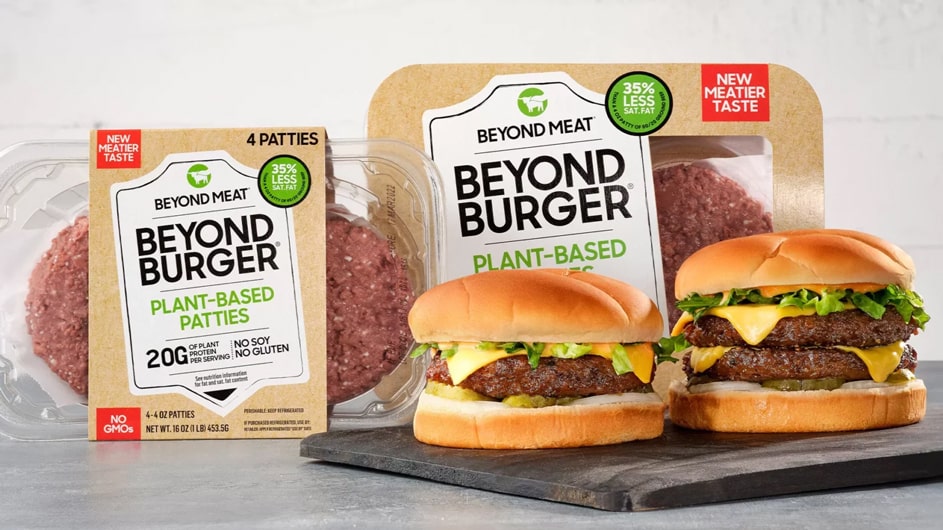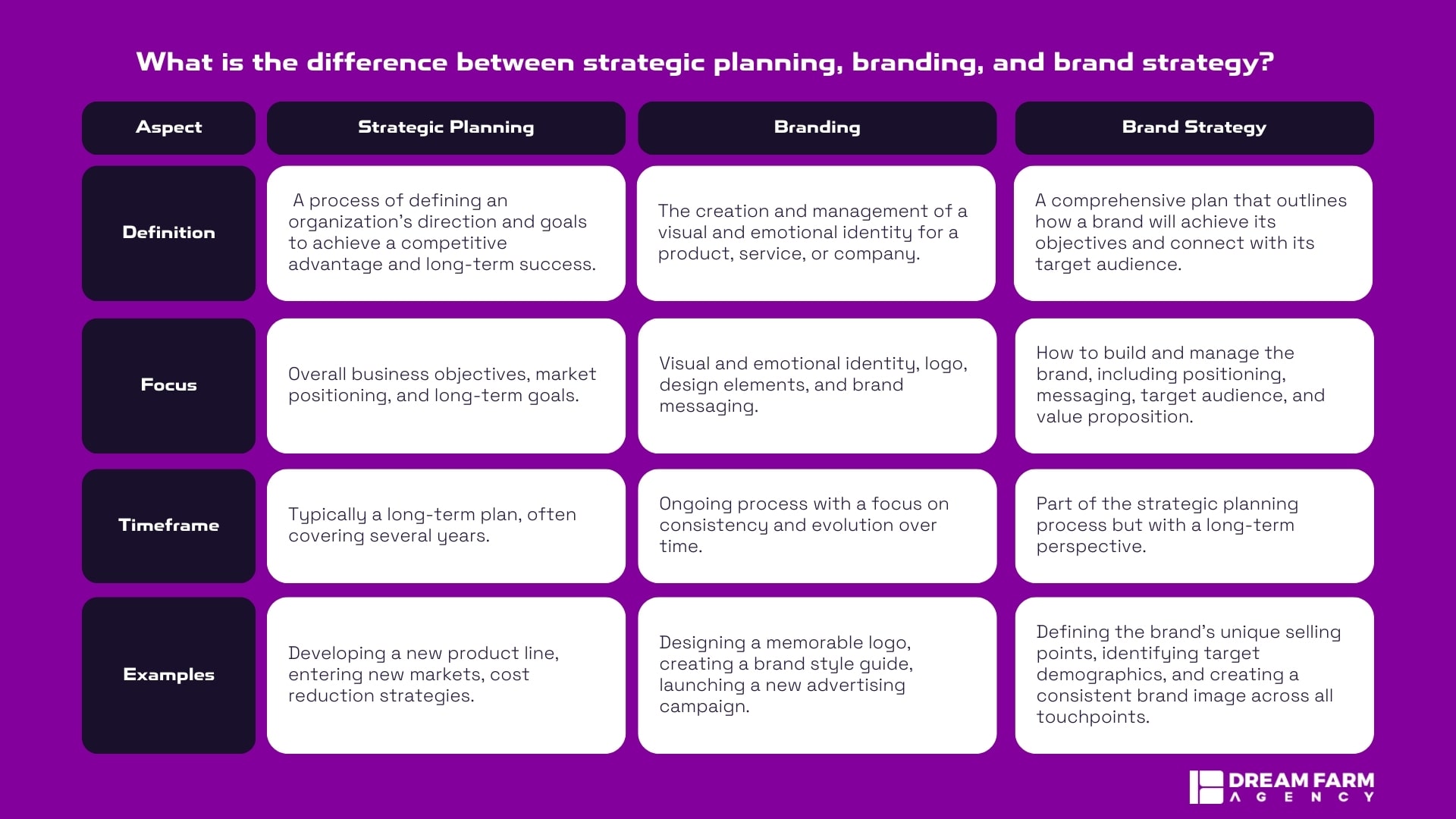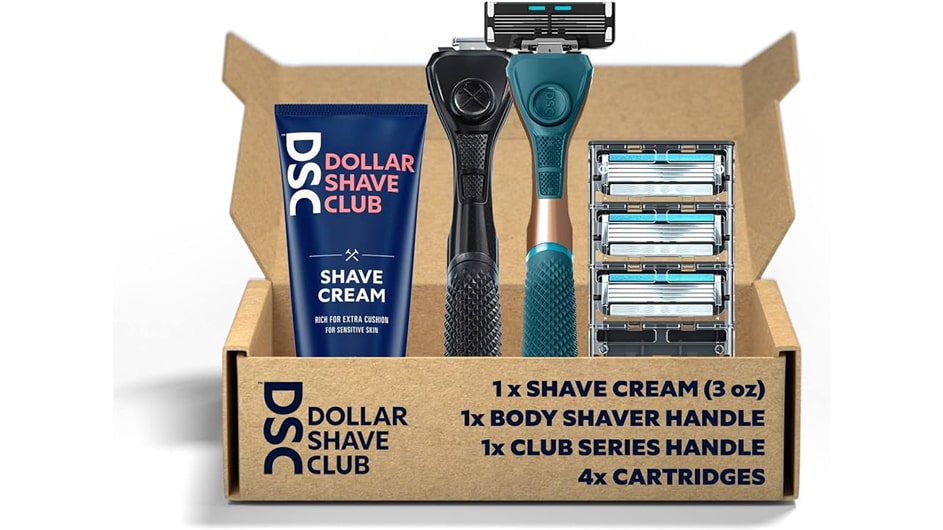
- What is a Brand Strategy?
- Brand plan important sections
- Important notes to develop your brand strategy
- Beyond Meat: Changing What It Means to Be a Successful Brand Today
- What Goes into a Successful Brand Strategy?
- What is the difference between strategic planning, branding, and brand strategy?
- Some examples of good brand strategies
- Brand Tactics vs. Brand Strategy
- In conclusion
We’re going to take the mystery out of brand strategy by giving you valuable tips and examples from real life in this blog post. Our goal is to provide brands, especially those new to the idea, the information and ideas they need to develop unique strategies.
What is a Brand Strategy?
A brand strategy is essential to a business plan because it shows how to build relationships and popularity in the market over time.
Our brand is like the face your business shows to the world. It’s all about your reputation and what makes you different from others.
Brand strategy is the plan you make to create this image. It involves deciding how you want your business to be seen and making sure everything you do helps show that image. It’s super important to get your brand strategy right to grab people’s attention and keep them interested.

The main thing in branding is to be clear about what your brand is all about:
- why it exists,
- what it stands for
- how it’s different from others
When you nail this down, it makes it easier for people to get what you do and choose you when they need something.
Also, a good brand helps people understand who they are.
We often choose brands that match how we see ourselves or want to be seen. This is called self-congruity, and it’s a cool way brands connect with us on a deeper level.
You can strengthen these connections by shaping your brand around what your customers aspire to be. This way, your brand doesn’t just sell stuff; it becomes a part of their life and identity.
Creating a unique brand is its primary goal, making customers more likely to choose the business over others.
People often get the wrong idea about brand strategies; they’re more than just names and colors.
Brand strategies focus on intangible factors that affect brand recognition, loyalty, and feelings over time.
This plan helps leaders, teams, and spokespeople shape the brand’s personality and behavior. It is also known as a brand development strategy.
It looks at the whole picture, including speech, stories, company branding, principles, and general vibe.
The plan includes the brand’s purpose, what it offers customers, and how to communicate clearly so that customers can recognize and choose the brand.
A brand strategy is the plan for how a company shows itself, sets itself apart from competitors, and connects with its customers.
It’s more than just pretty pictures; it shows the brand’s attitude, mindset, and how customers will feel it overall. As the brand’s framework, it answers important questions about how the brand acts in different scenarios and acts as a guide for consistent, powerful expression in the market.
Any brand needs a brand plan to help it navigate the ever-changing world of consumer tastes, new technologies, and market changes.

Brand plan important sections
Brand Identity: The visual and conceptual elements that distinguish and represent a brand.
Brand Purpose and Mission: The overarching reason for a brand’s existence and the values it aims to fulfill.
Target Audience: The specific group of consumers a brand intends to reach and engage with.
Brand Values and Culture: The principles and beliefs that guide a brand’s behavior and internal dynamics.
Brand Positioning: How a brand is perceived in the minds of its target audience relative to competitors.
Brand Voice and Messaging: The consistent tone and language to communicate the brand’s identity and values.
Customer Experience and Engagement: Customers’ interactions and satisfaction levels with the brand.
Brand Storytelling: The narrative that communicates the brand’s essence, purpose, and values.
Marketing Strategy: The comprehensive plan outlining how a brand will promote and sell its products or services.
Consistency: Ensuring uniformity in brand elements, messaging, and experiences across all touchpoints.
Brand Differentiation: The unique qualities or features that set a brand apart from its competitors.
Brand Extension and Diversification: Expanding a brand’s offerings or entering new markets to leverage existing brand equity.
Brand Partnerships and Collaborations: Collaborative efforts with other brands to enhance visibility and appeal.
Sustainability and Social Responsibility: A brand’s commitment to ethical practices, environmental impact, and societal contributions.
Digital Presence and Online Reputation: The brand’s visibility, interactions, and reputation in the digital space.
Employee Advocacy and Internal Branding: Engaging and aligning employees with the brand’s values for consistent representation.
Crisis Management: Strategies and actions taken to mitigate negative impacts on the brand during challenging times.
Measuring Success: Evaluating and quantifying the effectiveness of brand strategies and initiatives.
Global and Local Strategies: Balancing standardized and customized approaches for international and local markets.
Brand Community Building: Fostering a network of engaged customers and advocates around the brand.
Content Marketing: Creating and distributing valuable content to attract and engage the target audience.
Brand Experience: The overall impression and emotions evoked by interactions with the brand.
Important notes to develop your brand strategy
To make a strong brand strategy, you must carefully consider your target group, your unique value offer, and how it fits with your company’s overall goals.
Come up with a unique marketing statement:
First, boil down your brand’s core into a short, easy-to-remember sentence.
Take a look at “Pioneering the Future of Sustainable Cuisine” from the “Beyond Meat” brand. Come up with a phrase that people will remember, and that makes your brand stand out. The idea behind your whole brand plan will come from this sentence.
Explain what a compelling value proposition is:
Go beyond the qualities of the goods. Come up with a strong value statement like “Nourishing You, Nurturing the Planet” by Beyond Meat. Tell people about the unique benefits, addressing both health-aware and environmentally-conscious customers. With this offer, you set the stage for honest conversations with customers and make your brand seem like a thoughtful and important choice.
Get to know your audience:
Focus on getting to know the people you want to reach. Follow Beyond Meat’s lead and go after people who care about the environment and their health. By making specific customer profiles, you can connect with your audience on a personal level and build a brand plan that is true to their tastes.

Make sure your brand has a consistent vibe:
Make sure that the brand’s attitude comes through in every contact. Take ideas from Beyond Meat’s lively website design, clear product descriptions, and constant contact with customers. Keep this consistent on your website, marketing materials, product packages, and contacts with customers to earn their trust and love.

Make a brand plan that can be measured:
Make a brand plan with data that can be used to measure how well your business is doing. Key performance indicators (KPIs) that align with your brand goals include market share growth, customer involvement measures, and reviews of your brand’s impact on the environment. Check these measures often to see how well your brand plan is working. For instance, to see how well your method is working, keep an eye on changes in market share. Make intelligent changes to your brand plan based on these insights to ensure it stays flexible and on track with your goals.
Learn more about brand planning by examining how the modern icon Beyond Meat did it. They did a great job of positioning themselves at the intersection of health awareness, environmental awareness, and new food ideas.
Beyond Meat: Changing What It Means to Be a Successful Brand Today
Beyond Meat is a modern example of how to combine health awareness, environmental responsibility, and new food ideas in a way that works well. Beyond Meat is at the head of the plant-based change and has skillfully built a brand that speaks to a growing number of people looking for environmentally friendly food choices.

A Brand with a Purpose: The Important History of Beyond Meat
Beyond Meat is no longer just a company that sells plant-based foods; it has become a movement that supports a healthier, more environmentally friendly way of eating. Because more people want food that is good for the environment and doesn’t hurt animals, Beyond Meat has shaken up the traditional meat industry by giving its business plan a higher purpose. It has gained a large part of the market and become a sign of thoughtful purchasing.
What a Holistic Brand Plan Can Do for You, From Meeting Market Needs to Starting Conversations in Society.
Beyond Meat’s success shows that a well-thought-out brand plan can do more than just meet market needs. It can also help start meaningful conversations in society. Beyond Meat has shown how a brand can change the market and more extensive talks in society by connecting its brand with ideals that go beyond making money.
What Goes into a Successful Brand Strategy?
Building brand strategies on authenticity, consistency, and relevance leads to success.
It works well for brands to be natural, stay faithful, and be current in their marketing. Companies need a well-thought-out brand plan to stand out in a crowded market and connect with their customers on an emotional level. In this section, we will look at how to build a vital brand strategy step by step.
McKinsey did a study that showed that brands that are strong do 20% better than their competitors. Nielsen did another study that found 89% of people think that a strong brand is more likely to give them a good experience. Edelman did a study that showed 70% of people are more likely to buy from a brand that shares their values.
Let’s look at each of these things and how they fit into brand planning.
Authenticity: Being honest is a key part of running a great business. For example, Patagonia’s commitment to caring for the environment makes their goods better and helps them build a group of customers who share their ideals. This sincerity makes people buy and spreads through word of mouth, which shows how it affects company loyalty.
Consistency: In design, user experience, and message, consistency is like an unseen thread that holds everything together. Google’s dedication to a uniform design philosophy and user-friendly layout across all of its products is an excellent example of how this kind of consistency builds trust and helps people remember a brand. Customers will always see the same name, improving their total experience.
Relevance: In a world that changes quickly, it’s essential for brands to stay current. Spotify’s ability to quickly adapt to changes in the music business and offer new experiences shows how important it is to change and adjust cultural stories. Relevance is more than just adapting; it means actively adding to the cultural stories that make up your brand.
Coca-Cola is a timeless example of earnestness because it tries to make people happy and connects with them on an emotional level. It stays well-known worldwide by using classic elements like the color red and clear messages. Campaigns like “Share a Coke” and new products like Coca-Cola Zero show that the brand can change with the times and adapt to customer needs while keeping true to its core values. A brand plan that can be measured so that the company can see how it’s doing and make changes as needed.
What is the difference between strategic planning, branding, and brand strategy?
A lot of the time, the words “strategic planning,” “brand strategy,” and “branding” are used interchangeably in business development and market positioning. This makes a lot of people wonder if they all mean the same thing or if they each have their own meaning. Let’s look at the most important parts of brand strategy to clear up any confusion and learn how they work together to create a strong brand personality.

Strategic planning: The key to long-term success
The most essential part of any business is strategic planning, which includes thorough market study, analysis, and coming up with a long-term plan. It’s what points businesses in the direction of their vision by describing their goals, key strategies, and plans for long-term growth. Business Strategy, Strategic Plan, Brand Plan, Growth Plan, and Long-term Plan are all names that are often used to refer to the same thing. This shows how thorough this process is.
Brand Strategy: Bringing Out the Best in You
The brand strategy focuses on internal papers that spell out the core elements of the brand, while strategic planning sets the direction for the whole company. The targeting strategy, positioning/messaging strategy, portfolio architecture, and design strategy are all part of this. Brand strategy is a part of business strategy that looks at how a brand shows itself and how to make its personality stronger to resonate with people outside of the brand.
Branding: Making the Pattern of How People See You
Branding is the art of leaving a long image. It uses both internal and external assets that are carefully chosen to create a certain mental picture in people. The brand plan, which is made up of internal assets, describes what the brand is all about. External assets, on the other hand, show up in the form of natural things like product design, marketing plans, and brand activations that leave a lasting impression on customers.
To create a complete brand plan that connects with the target group and works well with overall business goals, it’s important to understand the subtleties of these terms. As we discover the complicated world of brand development, let’s look at each part to find out how to make a strong brand personality.
Strategic Planning: Getting Around in the Business World
Market study, analysis, and making a plan for long-term growth are all parts of strategic planning that set the stage for success. Whether it’s called a Business Strategy, Strategic Plan, or Growth Plan, the main idea is the same: it’s a plan for how to make a business successful.
Setting the brand’s soul: brand strategy
Through targeting, placement, and design strategies, the brand strategy builds the soul of the brand by looking at how it works on the inside. It forms the brand’s character and makes sure that it makes sense in the outside world. It is an important part of business strategy.
Branding: How to Make an Impression
Branding, which is the combination of internal and outward assets, tells a story that keeps people interested. The brand strategy is an internal asset that sets the tone. Product design, marketing plans, and brand activations are examples of external assets that bring the brand to life and make it stand out.
Some examples of good brand strategies
Let’s look into some less well-known but just as effective brand tactics.
1. Allbirds – Eco-Friendly Shoes:
Strategy for the brand: eco-friendly simplicity
Allbirds has changed the shoe business with a brand strategy that focuses on being eco-friendly and keeping things simple. Allbirds make their shoes from materials that can be used again and again, and they are very clear about how committed they are to be environmentally responsible. Allbirds has done a great job of positioning itself as a brand for people who want to buy eco-friendly goods without giving up style or comfort.

2. Away – Things You Need for Travel:
Modern travel lifestyle as a brand strategy
Away is a brand of luggage and travel items that has created a brand strategy that fits the way modern travelers live. Away has struck a chord with a generation that values experiences thanks to its sleek designs, smart features, and direct-to-consumer business plan. A strong social media presence and user-generated content are part of their plan to build a community around the brand.

3. Alternatives to Meat That Are Made from Plants:
Ethical Nutrition is the brand strategy.
Beyond Meat has changed the food business with a brand strategy that is based on healthy eating that is also ethical. Beyond Meat provides plant-based alternatives to traditional meat products to meet the growing need for environmentally friendly and animal-friendly food choices. The brand’s success comes from appealing to people who care about the earth and their health.
4. Casper: Beds, mattresses, and other sleep gear
Sleep Innovation and a Smooth Buying Experience Are Part of Our Brand Strategy.
Casper has changed the mattress business by focusing on sleep innovation and making the buying process easy. As part of their brand strategy, they stress their cutting-edge mattress technology, risk-free trial time, and direct-to-consumer model. Casper has successfully positioned itself as an industry disruptor, appealing to people who want to get a good night’s sleep.

5. Dollar Shave Club for Men’s Grooming:
Brand strategy: a disruptive subscription model and funny advertising
Story: Dollar Shave Club entered the men’s shaving products market with a new way of subscribing and funny ads. The Dollar Shave Club challenged big names in the grooming business by directly sending cheap, high-quality products to customers. The brand’s clever and approachable marketing worked well with younger people, which led to fast growth and success.

Brand Tactics vs. Brand Strategy
It’s important to know the difference between brand strategy and brand methods. Brand strategy is the long-term plan that guides a brand’s journey, while brand tactics are the short-term, concrete steps to reach instant goals. The world of Starbucks is a powerful example of this difference.
Brand strategy: seasonal items
It is very important to tell the difference between brand tactics and plans. As an example, Starbucks is very moving. Seasonal drinks are an intelligent way to attract customers by giving them a sense of what’s new and special. These strategies are meant to increase sales in the short term, get people talking, and adapt to changing buyer tastes.
However, Starbucks has a strong brand plan that goes beyond these short-term strategies. The coffee giant’s primary goal is to become known as a “third place”—a unique and friendly spot outside of home and work where people can relax, meet new people, and enjoy good coffee. This strategy vision is based on creating cozy coffee shops with soft seating, a welcoming atmosphere, and a dedication to providing a top-notch coffee experience.
The brand’s balance of tactics and strategy shows how they skillfully weave short-term moves into a bigger, more lasting story, making sure the brand stays relevant and robust over time.

In conclusion
Brand strategy has become the golden thread connecting progress and new ideas. Combining art, marketing, and technology is the key to standing out in a crowded market as we look deeper into great brand strategies. Curious about how art, marketing, and technology can work together for your brand? Contact us to learn more about our brand strategy services.

Rojan



